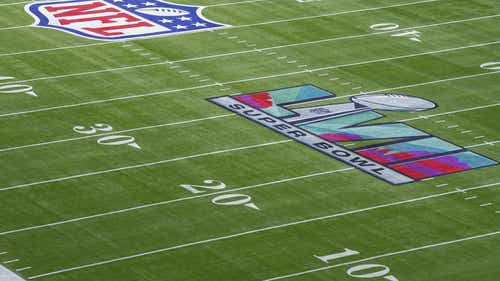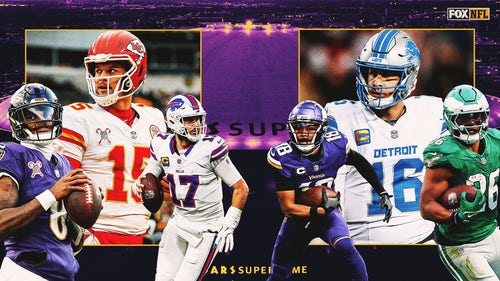
2022 NFL Draft: How the Eagles should use their 10 picks
By Rob Rang
FOX Sports NFL Analyst
The Philadelphia Eagles soared back into the playoffs last season, and with an NFL-high three first-round picks at their disposal (as well as more salary-cap space than in recent years), perhaps no team is better positioned to win the offseason.
The City of Brotherly Love might be feeling downright giddy about the strides the Eagles made in 2021, as the team jelled once rookie coach Nick Sirianni embraced a run-heavy offense. Philadelphia ultimately led the league in both rushing yards and rushing touchdowns, primarily due to young, dual-threat quarterback Jalen Hurts.
Sirianni and general manager Howie Roseman each endorsed Hurts at the combine, doubling down on their intention to surround the 24-year-old signal-caller with more weapons — on both the offensive and defensive sides of the ball.
Roseman has already taken a big step in doing so, convincing splashy free-agent edge rusher Haason Reddick (who played at Philadelphia’s own Temple University) to sign a three-year, $45 million deal and bringing back key starters such as defensive tackle Fletcher Cox and safety Anthony Harris on team-friendly one-year deals.
Now, let's take a look at how the Eagles can best use their current picks in the 2022 NFL Draft. Last week, we profiled the Seattle Seahawks and how they hope to rebuild their roster with Russell Wilson and Bobby Wagner playing elsewhere.
Following the pick-by-pick plan outlined below would help Philadelphia win in April and, more importantly, put them in position to keep winning in the fall.
First round, No. 15 overall (from Miami Dolphins): George Karlaftis, DE, Purdue
While Reddick was signed to bolster the Eagles’ pass rush, his frame and game fit better to the strongside linebacker role likely to be open with Genard Avery among the Eagles testing the open market, along with Derek Barnett and Ryan Kerrigan.
As such, adding a true hand-in-the-dirt defensive end likely remains a top priority, with Karlaftis possessing the size (6-foot-4, 275), strength, explosiveness and NFL readiness to warrant a mid-first-round selection. While perhaps not as twitchy off the edge as some of the rushers likely to be drafted ahead of him (such as Florida State’s Jermaine Johnson II and Georgia’s Travon Walker), Karlaftis is stouter at the point of attack and currently the better all-around player. In his three years at Purdue, he registered 29 tackles for loss and 14 sacks.
First round, No. 16 overall (from Indianapolis Colts): Andrew Booth, CB, Clemson
Roseman earned a three-year extension as Philadelphia’s primary decision-maker in part because he is such a savvy talent evaluator. As such, expect the Eagles to take full advantage of this year’s gifted cornerback crop, which, along with edge rusher and receiver, is one of the greatest strengths of the 2022 draft. Plugging just any rookie cornerback opposite a superstar such as Darius Slay, however, is a recipe for disaster.
Having starred for a perennial national title contender such as Clemson, Booth is used to playing at the highest level amid plenty of scrutiny. That kind of exposure to pressure is an underrated and very real element of projecting players at the next level, especially in a hard-edged environment such as Philadelphia. Booth is not only mentally mature but also fluid and instinctive in coverage, with terrific ball skills. He is also among the most physical and reliable open-field tacklers at the position in this class.
First round, No. 19 overall: Drake London, WR, Southern California
The Eagles invested first-round picks in receivers each of the past two years, but the 6-foot-4, 219-pound London plays a completely different style of ball than the silky-smooth DeVonta Smith (6-0, 170) and speedy Jalen Reagor (5-11, 197). London's brand of bully-ball has drawn plenty of comparisons to Tampa Bay Buccaneers star Mike Evans — and for good reason. London is a big receiver who actually plays big, using his size, strength and body control to win contested passes.
Hurts has significantly improved his accuracy since his early days at Oklahoma, but he remains more of a ballpark than precision passer, forcing receivers to adjust. This is one of the areas in which London, like Evans, excels. Both are not only gifted athletes but also ultra-competitive. Given Philadelphia’s running game and playmakers on the outside, teams won’t be able to dedicate multiple defenders to London, and therefore, he should be able to make a splash as a rookie.
Second round, No. 51 overall: Travis Jones, DT, Connecticut
Even after a decade, the 31-year-old Cox remains one of the NFL’s most formidable and dependable defensive tackles. However, the Eagles would be wise to consider finding him a protégé, and the 6-foot-4, 324-pound Jones, who rag-dolled opponents throughout Senior Bowl week, certainly fits the bill.
Like Cox, Jones is simply bigger, longer (34 3/8-inch arms) and stronger than even the behemoths along the line of scrimmage in the NFL. Jones lacks the quick-twitch pass-rushing ability of some of this year’s smaller defensive tackles, but given the speed Philadelphia has on the outside, Jones should be able to bulldoze through the one-on-one blocks he’ll likely face early in his career.
Third round, No. 83 overall: Brian Asamoah II, ILB, Oklahoma
Even with the addition of Reddick, off-ball linebacker remains a position of concern for Philadelphia, though much of that is by design. The Eagles have historically focused their attention on other positions, not using a first-round pick on a traditional linebacker since 1979 (Jerry Robinson). Last season, the Eagles' leader in tackles was former CFL convert Alex Singleton, who was signed in free agency by Denver.
Incumbent starter T.J. Edwards has the instincts and physicality to take over as the Eagles’ primary tackler, but he lacks ideal speed and agility, which is where Asamoah excels. At 6-foot, 226 pounds, Asamoah does not possess the bulk teams traditionally value at linebacker, but he punches above his weight class. Plus, he's an excellent athlete, registering a 4.56-second time in the 40-yard dash and a 36.5-inch vertical jump. With his speed and aggressiveness, Asamoah could be a plug-and-play replacement for Singleton on defense and special teams.
Fourth round, No. 124 overall: Kerby Joseph, FS, Illinois
Anthony Harris played well in his first season with the Eagles, serving as a coach on the field for defensive coordinator Jonathan Gannon after both were signed away from the Minnesota Vikings. Savvy and a good communicator, Harris might be the perfect tutor for a talent such as Joseph, who did not emerge as a full-time starter for Illinois until this past season. Then he exploded for five interceptions, tying him for the national lead in the regular season.
Harris has recorded 10 interceptions in his seven-year NFL career, with six of them coming in just 14 games in 2019 — Gannon’s first year working with him in Minnesota. With Harris returning on just a one-year deal, the Eagles would be wise to take advantage of their 10 draft picks (and this year’s good safety class) to plan for the future.
Fifth round, No. 154 overall (from Washington Commanders): Chigoziem Okonkwo, H-Back, Maryland
If the Eagles are going to build around Hurts, adding versatile weapons to complement his dual-threat ability makes a lot of sense. Okonkwo is not a traditional hand-in-the-dirt tight end like Philadelphia’s current star, Dallas Goedert, a 6-foot-5, 256-pounder who took his game to another level after the club traded Zach Ertz to Arizona last season.
At a more compact 6-foot-2½ and 238 pounds, Okonkwo is at his best in motion and on the wing, taking quick passes and utilizing his rare speed. Scouts at the combine clocked Okonkwo in the high 4.4s to low 4.5s in the 40-yard dash. I saw his speed in person at the East-West Shrine Bowl, where the former Maryland Terrapin was virtually uncoverable, whether lining up out of the slot, at tight end, at H-back or even at fullback.
Okonkwo comes with medical questions that could give some teams pause. He was diagnosed with myocarditis (inflammation of the heart muscle) and sat out the 2020 season. Under Roseman, the Eagles have repeatedly gambled (and won) on players with durability red flags (Landon Dickerson, Josh Sweat and Isaac Seumalo, among others), so they could see Okonkwo presenting similar value.
Fifth round, No. 162 overall: Hassan Haskins, RB, Michigan
The Eagles might opt to bring back bullish interior runner Jordan Howard, but an underrated crop of rookies at the position could convince the team to seek a younger, cheaper alternative. Like the 6-foot, 224-pound Howard, Haskins (6-2, 228) is a true pile-mover with great leg drive and enough juice to handle full-time duties, should lead back Miles Sanders miss time, as he has the past two seasons.
Haskins is best known for his dominant performance against Ohio State last season, running for 169 yards and a staggering five touchdowns to catapult the Wolverines into the College Football Playoff. He scored 30 touchdowns for Michigan in his three-year career yet has plenty of tread left on his tires. Further, he was the epitome of dependability, not fumbling once in 476 career touches.
Fifth round, No. 166 overall (from Arizona Cardinals): Kyron Johnson, DE/OLB, Kansas
With so many picks in a class loaded with quality edge rushers, Roseman might follow the notion that a club can never have too many at the position. A true combine snub, Johnson wowed scouts at Kansas' Pro Day, clocking in at 4.40 seconds in the 40-yard dash and posting a 39.5-inch vertical jump after measuring in at 6-0, 231 pounds.
Far from just a workout warrior, Johnson flashed at the Senior Bowl, knocking down two of the best blockers in Mobile with his shocking explosiveness. Last season for the Jayhawks, he had a career-high 63 tackles (including 8.5 for loss and 6.5 sacks) and four forced fumbles. Capable of rushing or dropping back into space, Johnson offers some of the same versatility that drew the Eagles to Reddick.
Sixth round, No. 194 overall (from Colts): EJ Perry, QB, Brown
Some have clamored for the Eagles to join the quarterback carousel spinning through the NFL this offseason. Given Philadelphia's draft assets and potential salary-cap flexibility, it is entirely possible that Roseman and Sirianni will look for an upgrade to a QB depth chart that currently lists Hurts, veteran Gardner Minshew and Reid Sinnett. Even if Philly remains true to its stated plan to stick with Hurts as the starter, investing in a young quarterback with upside is good business.
Perry signed with Boston College out of high school but transferred to Brown two years later. There, he emerged as arguably the Ivy League’s biggest star in two seasons as a starter. He capped his career as the conference’s Offensive Player of the Year.
Overshadowed by quarterbacks with more name recognition at the East-West Shrine Bowl, Perry quietly turned heads, emerging as the most intriguing QB prospect in Las Vegas prior to an impressive showing at the combine. Do not let the Ivy League background fool you: Perry isn’t just smart; he’s also athletic.
One of the most recognized names in the industry, Rob Rang has been covering the NFL Draft for more than 20 years, with work at FOX, Sports Illustrated, CBSSports.com, USA Today, Yahoo, NFL.com and NFLDraftScout.com, among others.








